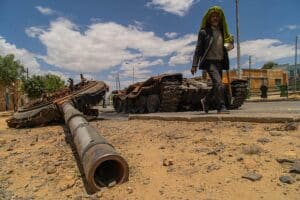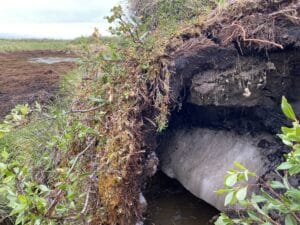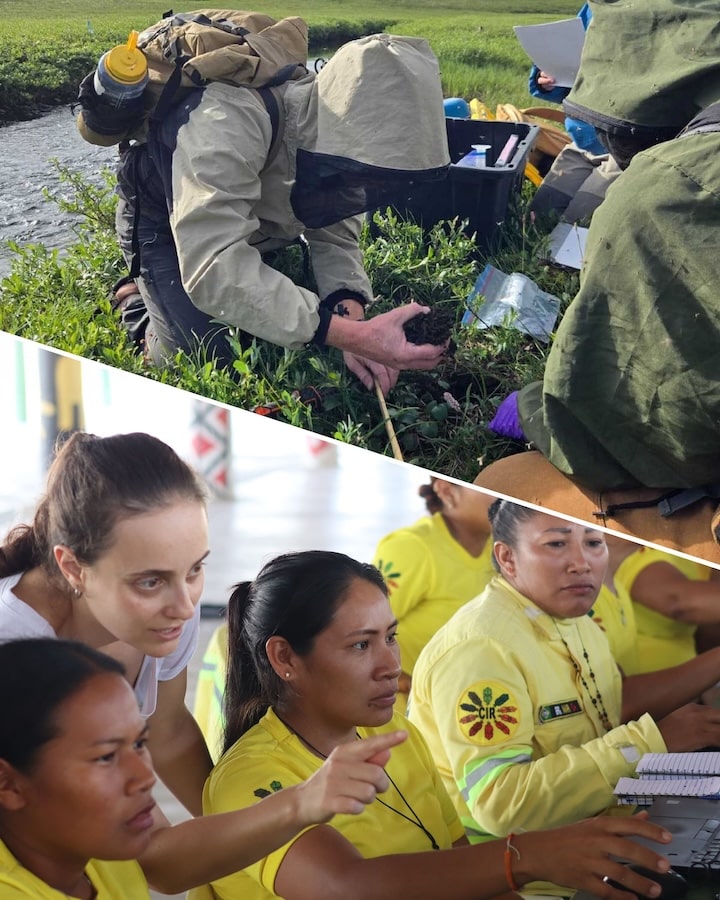Feeding Resilience: Ethiopia
Compound security, hunger, and climate risks

A Crossroads for Conflict, Food, and Climate
Ethiopia sits at the intersection of climate change, food security, and conflict risks that will shape the country’s internal stability, influence on East African security, and geopolitical role for years to come.
In a comment published in Nature Climate Change, Mark Bradford, the E.H. Harriman Professor of Soils and Ecosystem Ecology, and Yale School of the Environment research scientists Sara Kuebbing and Alexander Polussa ’25 PhD, together with colleagues Emily Oldfield ’05, ’11 MESc, ’19 PhD, of Environmental Defense Fund (EDF) and Jonathan Sanderman of the Woodwell Climate Research Center, argue that the scientific evidence supporting soil carbon’s role in mitigating climate change remains too weak to meet the standards required for policy and carbon markets.
Read more here.
On September 19, Woodwell Climate submitted public comment on the U.S. Forest Service’s proposed rulemaking to rescind the 2001 Roadless Area Conservation Rule, also known as the Roadless Rule. This rule banned logging and the creation of new logging roads in 58 million acres of National forests.
The federal agency’s intent to rescind the Roadless Rule aligns with the presidential Executive Order, “Unleashing Prosperity through Deregulation” which seeks to remove obstacles to extracting natural resources on public lands. Additionally, the agency claims the repeal of the rule will allow forest managers to remove trees from “overstocked forests” to prevent wildfire and disease.
Woodwell Climate strongly opposes the rescission of the rule, citing the best available science that shows increased roadways and subsequent logging will result in ecological degradation, increased wildfire, and loss of critical carbon stocks.
“The Roadless Rule currently protects millions of acres from extractive activities that would result in ecosystem degradation and increased vulnerability to wildfire,” writes Senior Scientist Rich Birdsey in the comment. “Rescinding the Roadless Rule would harm many public uses of the land, cause significant emissions of greenhouse gases, and destroy critical habitat for many species of wildlife.”
Federal forests have major carbon storage and climate mitigation potential, absorbing approximately 3% of U.S. emissions from fossil fuel burning each year. Mature and old growth forests are responsible for the majority of that, and the Roadless Rule has been instrumental in preventing the logging of these important forests, including the Tongass National Forest in Alaska.
“Increased logging is the single greatest threat to these forests and the carbon they hold — and it is the threat we most directly control,” the Woodwell Climate comment states. “As the impacts of climate change become more extreme and damaging, we should prioritize protecting mature and old growth forests on federal lands, not harvesting them.”
Additionally, studies show that road building into previously undisturbed forests actually increases vulnerability to fire. This is because most wildfires are caused by human ignitions which become more common with better access roads. Undisturbed mature and old-growth forest ecosystems are also more resilient to wildfires compared to forests that are actively logged and managed.
Read the full public comment here.
Huge danger from permafrost loss

With the Arctic warming four times as fast as the rest of the globe, and fires now routinely burning large swaths of northern forests, carbon stored in permafrost is rapidly escaping into the atmosphere where it can warm the planet even faster. Edward Alexander, Senior Arctic Lead at the Woodwell Climate Research Center and a Co-Chair of the Gwich’in Council International, speaks with Host Jenni Doering about the enormous climate risks of permafrost loss and how Indigenous cultural practices can help protect this vital resource.
When it comes to sucking carbon dioxide out of the atmosphere, trees and forests are well-known champions. But when it comes to sequestering methane, their role is much more complicated. Forest ecosystems sometimes absorb methane, other times they emit it — creating a complex exchange of gases that scientists are only beginning to understand. Boreal forests across Canada, Alaska, Scandinavia, and Russia can sometimes be methane sinks, but they’re also set to become major emitters as climate change accelerates.
That’s the challenge the Boreal Biosequester project is tackling. By deploying newly developed methane detecting chambers at Howland Research Forest in Maine, Woodwell Climate Associate Scientist Dr. Jennifer Watts and Senior Research Scientist Kathleen Savage, along with collaborators from Arizona State University and University of Maine Orono plan to measure methane flows on a granular level to understand which bacteria consume it and how they function across the ecosystem.
Once they’ve mapped these methane-munching microbes—called methanotrophs—across varying tree species, temperatures, and seasonal shifts, the researchers want to publish their findings so governments, land trusts and foresters can enhance the activity and presence of these climate superstars, transforming ecosystems from methane sources into sinks.
Why methane matters
Methane has been overlooked in climate discussions, which largely focus on carbon dioxide, but it’s 87 times more powerful at trapping heat over a 20 year period. Atmospheric levels of methane are now 2.6 times higher than pre-industrial levels—the highest they’ve been in 800,000 years. Crucially, methane emissions from boreal forests are expected to rise or even double as temperatures rise.
Natural environments, such as wetlands and forests, account for a large portion of global methane emissions, which is why finding nature-based solutions to bring down emissions is such an important area of research. Boreal Biosequester’s approach offers the chance to turn natural sources into sinks, while also providing co-benefits such as enhanced biodiversity, wildlife habitats, flood reduction, erosion prevention, and improved air quality.
“If the methanotrophs are there, why not learn to work with them as effectively as possible?” says Watts. “If we were to work with human technology to reduce methane, you’d have to build something energy-intensive. This is a passive way to work with the forest sustainably. If we leave a forest to grow or regenerate, or if we afforest, we can both draw down CO2 and, we hope, consume methane.”
The genesis of the project
Watts and Savage were initially looking at methane sources and sinks for the US National Science Foundation. At first, they focused on soils, which were at the time considered the primary drivers of whether forests were sources or sinks. Then a groundbreaking paper revealed trees’ crucial role in methane uptake. With microbial ecologist Dr. Hinsby Cadillo-Quiroz from Arizona State University, they decided to study methane fluxes around tree trunks and canopies as well as in the soil, and sought funding from CarbonFix to carry out this study.
“When we looked at the canopy level, we could see net consumption, but soil data were all over the place,” Watts explains. “The data showed something important happening between the soils and treetops.”
The world of methanotrophs on plant surfaces is largely uncharted. The team will isolate and study these bacteria in labs while measuring methane consumption across soils, trunks, and canopies through different seasons and climates.
“We’re really the explorers venturing into this new micro-universe,” says Watts. “We know there are microbes out there, we just need to get to know them.”
Only in the last 15 years could methane gas be measured accurately at this scale. The team is uniquely positioned at Howland Forest, which has rare historical methane flux data from eddy covariance towers (structures measuring the exchange of gases) dating to 2011, plus access to both pristine and harvested forest areas for direct comparison.
The Method
CarbonFix’s grant will be used for the first phase to map methanotroph behavior and measuring fluxes across forest layers across the course of a year. Once they’ve secured additional funding, the team will identify optimal conditions for methane consumption across different tree species and environments. Next, they’ll test hypotheses in greenhouse settings, demonstrating how specific tree species can convert methane-emitting wetlands into methane-consuming ecosystems.
Finally, they’ll share findings through reports and presentations targeting governments, land trusts, foresters, and carbon markets to implement these practices in forest management.
Potential impact
For now, the team will focus on working out how methanotrophs function, and the conditions in which they thrive.
“A tiny creature, like a methanotroph, can influence a tree in many ways: it can fix nitrogen, it can clean metabolites. But the true beauty of this partnership is that a single tree could host methanotrophs in many ways and a thousand trees can host methanotrophs in a million ways. We just need to figure out how to channel this partnership to remove many tons of methane molecules. Achieving that would be a major breakthrough to help gain time against climate change,” says Cadillo-Quiroz.
The findings may extend beyond forests to landfills, agriculture, logging, or fire-damaged areas — countless applications where understanding and influencing methane fluxes through bacteria could prove transformative.
What’s more, if the team’s findings show how methanotrophs can be inoculated into new forests, they could become part of every new reforestation project.
Reforestation is urgently needed: between 2001-2023, Canada, Alaska, and the Northern US lost over 70 million hectares of forest — three times the UK’s landmass — from fire and harvest. Most of these wet soil areas are net methane emitters. Reforesting and inoculating them with methanotrophs could create carbon and methane sequestration superheroes. The team estimates targeted afforestation could remove over 10 million metric tons of methane — reducing 30-40% of high-latitude methane budgets while simultaneously sequestering CO2.
But for now, there’s lots of work to be done. The team of four are rolling up their sleeves for fieldwork and lab analysis.
“At minimum, it will be fascinating data filling knowledge gaps about methane uptake,” says Savage. “If we can remove methane short-term, we have leeway to address more challenging CO2 elements requiring extensive work.”
Watts adds: “Our group is always thinking about how what we do now will impact society later. I’m excited to develop methodologies that we can share worldwide, creating community transformation for people across the planet.”
This week, Director of Government Relations Laura Uttley, Senior Scientist Dr. Sue Natali, and Senior Scientist Dr. Brendan Rogers were appointed to Woodwell Climate’s three endowed chairship positions to honor their leadership in the field of climate research and policy.
These appointments are professional distinctions that honor the living legacy of Sally Shallenberger Brown, Dr. George Woodwell, and Dr. Richard “Skee” Houghton, whose vision and leadership continue to guide work at the Center. The endowed funds provide salary support for a renewable three-year term, annual stipends, and recognition of the appointee’s leadership.
“I’m thrilled to announce the appointment of these remarkable experts to Woodwell’s three endowed chairs,” said Woodwell Climate President and CEO Dr. Max Holmes, who led the selection committee along with Drs. John Holdren and Jennifer Francis. “This public recognition of their extraordinary contributions, along with the support provided by the endowments, will unlock exciting opportunities to advance climate solutions.”
The Sara Shallenberger Brown Chair of Environmental Policy
Laura Uttley, Director of Government Relations
Sara Shallenberger Brown was an influential environmentalist and philanthropist who served on the boards of many environmental and conservation nonprofits throughout her lifetime, including Woodwell Climate (then Woods Hole Research Center).
The Brown chairship recognizes Uttley’s fifteen years of experience bridging science and policy in Washington, D.C. She has developed federal advocacy strategies and facilitated outreach to policymakers, ensuring that Woodwell Climate’s leading research influences policy development and implementation. Prior to joining Woodwell, Uttley worked at Lewis-Burke Associates and served in the offices of Congressman James Langevin, Senator Jack Reed, and the Assistant Secretary of Defense for Legislative Affairs. She is also a Truman National Security Project Political Partner and teaches advocacy at American University. Her expertise and leadership embody the Brown Chair’s mission of connecting science with conservation and policy at the highest levels.
The George M. Woodwell Chair in Conservation
Dr. Sue Natali, Senior Scientist
George Woodwell was not only the founder of the Center, but a pioneer and visionary whose scientific inquiries hit on the biggest environmental issues of the late twentieth century, including DDT, nuclear radiation, and “the carbon dioxide problem.”
Natali is a leading Arctic climate scientist whose pioneering research on permafrost thaw has deepened our understanding of the immense risks it poses. She directs the Permafrost Pathways initiative, funded through the TED Audacious Project, which brings together scientists, policymakers, and Indigenous communities to inform equitable adaptation and mitigation strategies. Natali’s commitment to collaboration, her extensive fieldwork across the Arctic, and her global engagement exemplify the legacy of George Woodwell, our founder, whose vision was to unite science and conservation for lasting impact.
The Richard “Skee” Houghton Chair in Carbon Cycle Science
Dr. Brendan Rogers, Senior Scientist
Since becoming one of the Center’s first employees, Skee Hougton has shaped the organization as its Acting Director & President, and his research field, notably contributing to the reports of the Intergovernmental Panel on Climate Change, which was awarded the Nobel Peace Prize in 2007.
Rogers’ research focuses on boreal forests and Arctic tundra, with particular emphasis on wildfire, permafrost thaw, and their consequences for the global carbon cycle. He integrates field measurements, satellite observations, and modeling to understand rapidly changing northern ecosystems and to inform resource management and policy. As co-lead of Permafrost Pathways, Rogers has emerged as a global leader in translating science into action, embodying the tenacity, rigor, and collaborative spirit that defined Dr. Houghton’s career.




